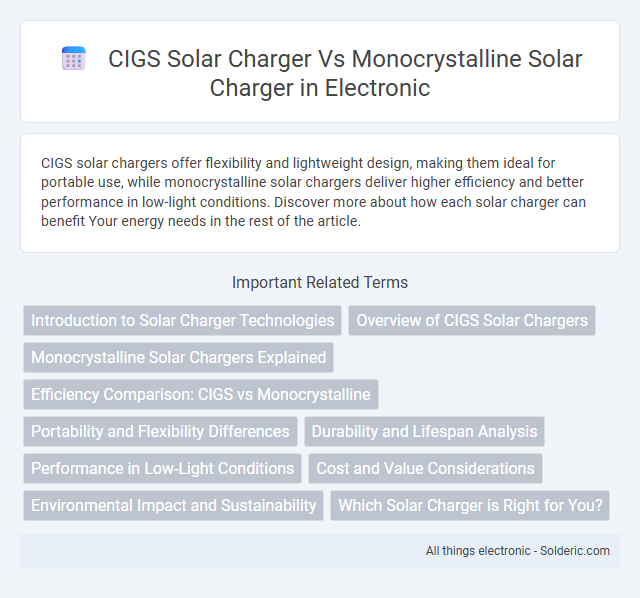CIGS solar chargers offer flexibility and lightweight design, making them ideal for portable use, while monocrystalline solar chargers deliver higher efficiency and better performance in low-light conditions. Discover more about how each solar charger can benefit Your energy needs in the rest of the article.
Comparison Table
| Feature | CIGS Solar Charger | Monocrystalline Solar Charger |
|---|---|---|
| Efficiency | 12% - 14% | 15% - 20% |
| Flexibility | Flexible and lightweight | Rigid and heavier |
| Durability | Moderate, sensitive to moisture | High, robust and weather-resistant |
| Performance in Low Light | Better performance under shade and low light | Good, but less efficient in low light |
| Cost | Generally lower cost | Higher cost due to manufacturing process |
| Lifespan | 5-10 years | 20-25 years |
| Application | Portable devices, flexible solar products | Home installations, high power applications |
Introduction to Solar Charger Technologies
CIGS solar chargers utilize Copper Indium Gallium Selenide thin-film technology, offering lightweight, flexible panels with moderate efficiency around 15-18%. Monocrystalline solar chargers employ high-purity silicon crystals, delivering higher efficiency rates typically between 20-22% and superior performance in low-light conditions. The choice between CIGS and monocrystalline depends on factors such as portability, durability, and energy output requirements for specific solar charging applications.
Overview of CIGS Solar Chargers
CIGS solar chargers utilize thin-film copper indium gallium selenide technology, offering flexibility and lightweight design compared to rigid monocrystalline panels. These chargers perform well in low-light conditions, making them suitable for varied environments while maintaining moderate efficiency levels around 15-18%. Your choice between CIGS and monocrystalline depends on the balance you need between portability and peak power output.
Monocrystalline Solar Chargers Explained
Monocrystalline solar chargers are made from single-crystal silicon, offering higher efficiency rates of around 15-20% compared to CIGS solar chargers, which typically range between 10-12%. These solar chargers perform better in low-light conditions and have a longer lifespan due to their durable and stable structure. Your device will benefit from faster and more consistent charging with monocrystalline panels, especially in outdoor or mobile scenarios.
Efficiency Comparison: CIGS vs Monocrystalline
CIGS solar chargers offer flexibility and lightweight design but typically deliver efficiency rates between 12-15%, whereas monocrystalline solar chargers achieve higher efficiency, often ranging from 18-22%. Monocrystalline panels convert more sunlight into electricity, making them ideal for maximizing power output in limited space. Choosing between the two depends on your need for portability versus efficiency performance during solar charging.
Portability and Flexibility Differences
CIGS solar chargers offer superior flexibility due to their thin-film design, allowing them to bend and conform to curved surfaces, which makes them highly portable for outdoor activities and irregular spaces. Monocrystalline solar chargers, while usually more rigid and less adaptable, provide higher efficiency in compact sizes, making them ideal for users prioritizing power-to-portability ratio in a solid form factor. Your choice depends on whether you value flexibility and lightweight portability or peak efficiency within a durable, structured panel.
Durability and Lifespan Analysis
CIGS solar chargers offer greater flexibility and impact resistance due to their thin-film construction, making them less prone to physical damage compared to rigid monocrystalline solar chargers. Monocrystalline solar chargers typically provide higher efficiency and a longer operational lifespan, often exceeding 25 years, whereas CIGS panels generally last around 10-15 years due to faster degradation rates. Your choice between the two should consider usage conditions, with monocrystalline being ideal for long-term durability and CIGS suitable for portable, lightweight applications requiring moderate lifespan.
Performance in Low-Light Conditions
CIGS solar chargers outperform monocrystalline solar chargers in low-light conditions due to their higher efficiency at diffused sunlight and shaded environments. The thin-film CIGS technology maintains better energy absorption with less direct sunlight, making it ideal for overcast days or indoor use. Your choice of a solar charger for variable lighting should consider CIGS if consistent power generation under low-light scenarios is crucial.
Cost and Value Considerations
CIGS solar chargers typically offer lower production costs due to their flexible thin-film technology, making them more affordable for budget-conscious consumers. Monocrystalline solar chargers provide higher efficiency and longer lifespan, which translates to better long-term value despite their higher initial price. Evaluating both options depends on the balance between upfront cost savings with CIGS and the greater energy output and durability of monocrystalline panels.
Environmental Impact and Sustainability
CIGS solar chargers offer a lower environmental footprint due to their flexible, thin-film technology, which requires less raw material and energy during production compared to monocrystalline solar chargers. The manufacturing process of CIGS modules generates fewer toxic byproducts, enhancing sustainability efforts in solar energy solutions. While monocrystalline solar panels deliver higher efficiency, their production involves more intensive mining and energy use, resulting in a larger carbon footprint and more significant environmental impact over their lifecycle.
Which Solar Charger is Right for You?
CIGS solar chargers offer flexibility and lightweight designs, making them ideal for portable use and uneven surfaces, while monocrystalline solar chargers provide higher efficiency and better performance in limited space or low-light conditions. Choosing between these technologies depends on your priorities: portability and durability favor CIGS, whereas maximum power output and consistent performance suit monocrystalline panels. Evaluate your charging needs, typical environmental conditions, and device compatibility to select the solar charger that best meets your lifestyle and energy requirements.
CIGS solar charger vs Monocrystalline solar charger Infographic

 solderic.com
solderic.com